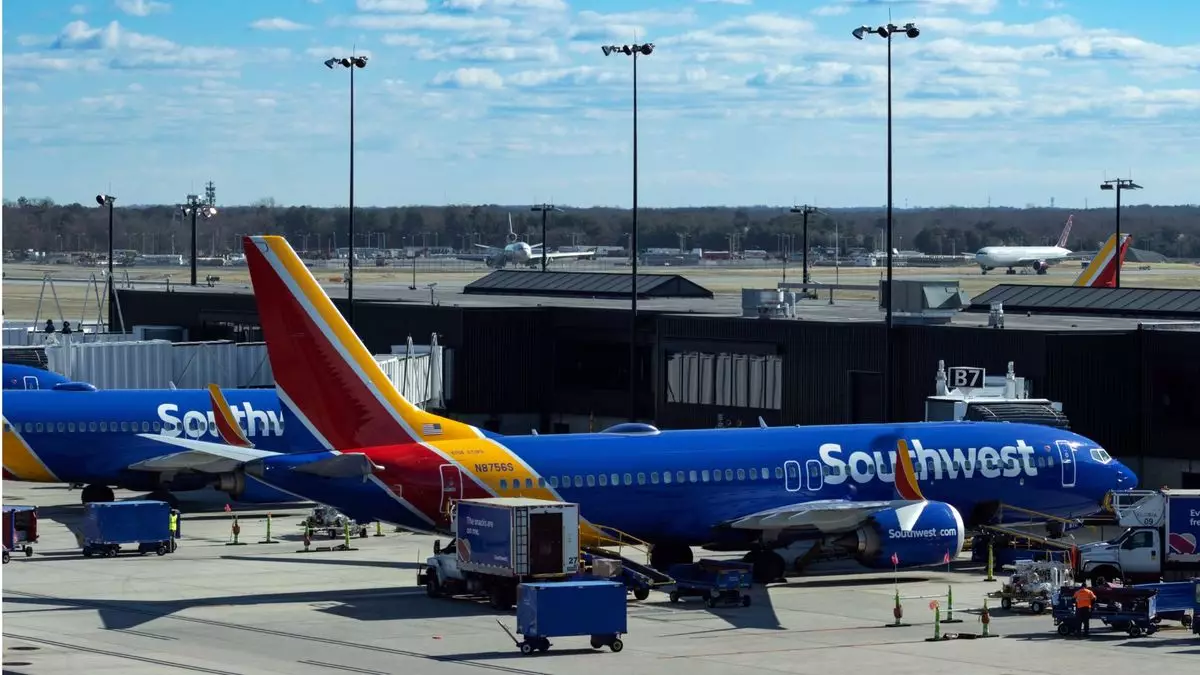The landscape for airlines can shift in a matter of months, and the recent evolution of Southwest Airlines is a testament to this volatility. With an ambitious transformation plan in place, the airline aims to significantly enhance its financial standing and investor attractiveness. However, internal friction and mounting pressure from shareholders could derail these efforts before they truly take off.
In recent months, Southwest Airlines has undertaken a three-year transformation initiative designed to achieve an additional $4 billion in revenue by 2027 and elevate its operating margin from a meager 1.2% in 2024 to a more competitive 10%. Key to this strategy is the introduction of assigned seating and the addition of extra-legroom seats, elements anticipated to bolster customer service and revenue.
However, ambitious plans often require a careful balance of execution and adaptation. Market experts suggest that the measures Southwest has proposed will not be sufficient unless they also address some core competitive threats. The company has faced growing challenges in realizing its fair share of industry revenue despite a modest 5.3% increase in overall revenue and a net income of $261 million in 2024. The airline’s operating margins fall short compared to industry stalwarts like Delta and United, prompting analysts to highlight the importance of creating more diverse premium offerings if Southwest wants to regain its competitive edge.
The role of Elliott Investment Management as a significant stakeholder cannot be overlooked. Following its investment in Southwest, the hedge fund entered into a cooperation agreement that brought five of its chosen board members into the fold. This shift now raises questions about the sustainability of Southwest’s strategic direction and the accelerated pressure for change.
The expectation from Elliott—known for its fast-action, result-oriented strategies—may be weighing heavily on Southwest’s leadership and staff. According to industry consultant Bob Mann, there is an urgent demand for rapid outcomes, which seems at odds with the airline’s existing three-year framework. The stakes are high, as the company’s share price remains stagnant around $30, falling short of Elliott’s target of $49—a reflection of the dissatisfaction that can reverberate through investor circles.
Major organizational changes have already unfolded within the company, including the layoff of approximately 1,750 corporate-level employees—the first mass job cuts in Southwest’s history. This mass layoff aligns with plans to save $300 million in the upcoming fiscal year, but it raises concerns about the internal climate and alignment within the company.
The recent resignations of key executives, including Chief Transformation Officer Ryan Green and CFO Tammy Romo, have further fueled speculation about a disconnect between the board and operational leaders. The swift departure of these executives is seen by analysts as indicative of growing discontent and divergence of opinion regarding the company’s strategic trajectory.
Without a doubt, the new board and investor urges for a more aggressive approach could be stoking discontent within the ranks. Analysts suggest that these changes are symptomatic of a misalignment of vision—an indication that some existing leaders may feel that the transformative objectives no longer mirror their aspirations.
Above and beyond leadership dynamics, Southwest faces significant challenges related to cost management. The airline’s cost per available seat mile (CASM) is higher than that of many low-cost carriers, encroaching on levels maintained by the traditional ‘Big Three’ airlines. These larger carriers can leverage higher revenues from premium services such as first-class offerings, a segment Southwest does not currently tap into.
While the recent layoffs might suggest a commitment to reducing cost growth, analysts warn that expectations for rising costs in the near future—predicted to increase between 7% and 9%—could impede the airline’s efforts to improve its operating margin. Without a systematic approach to not only control costs but enhance revenue through competitive differentiators, Southwest risks lagging behind.
As it grapples with these multifaceted challenges, speculation abounds regarding the potential for Southwest to consider acquisitions as a means to accelerate growth. With Elliott’s increasing stake—now at 13.4% and a projected 19.9% cap—there’s heightened scrutiny on whether Southwest might pursue strategic acquisitions to enhance its portfolio and market positioning.
The potential acquisition of other carriers, notably JetBlue or Spirit, has surfaced in discussions, suggesting a possible pivot that could reshape the competitive landscape in favor of Southwest. However, such moves will necessitate careful regulatory navigation, particularly in an evolving political climate.
Southwest Airlines stands at a pivotal junction where strategic ambitions must align closely with investor expectations and internal operations. Balancing transformation with stakeholder satisfaction requires a deft hand and a forward-thinking approach. As the airline undergoes these transformations, its success will depend on the ability to adapt, innovate, and ultimately regain its status as a frontrunner in the industry.


Leave a Reply